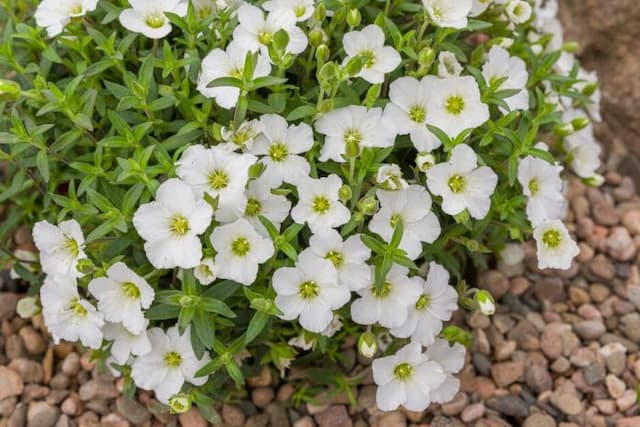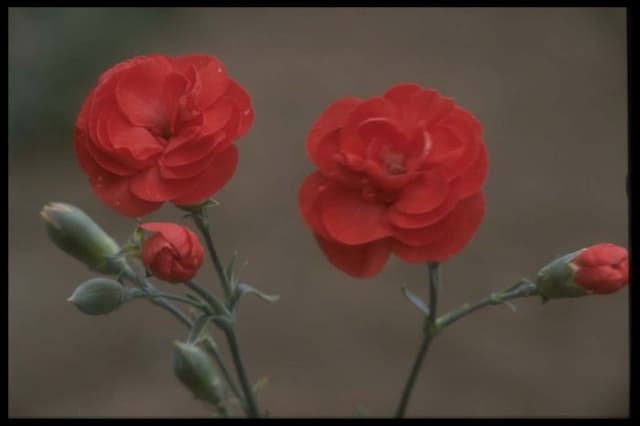Carnation Dianthus 'Starlette' (PBR) (Star Double Series) (p)

ABOUT
The Dianthus 'Starlette', part of the Star Double Series, is a strikingly beautiful plant known for its vibrant and showy flowers. The blossoms are double-flowered, which means they have multiple layers of petals, giving them a full, ruffled appearance that resembles a miniature carnation. The petals boast a rich hue, often a mix of bold pink or red shades with contrasting lighter pink or white edges, creating a star-like pattern that is particularly eye-catching and gives the plant its name. Each flower is neatly perched atop slender, sturdy stems that emerge from mounds of narrow, grass-like foliage. The leaves are typically blue-green to gray-green in color, which elegantly complements the brilliant colors of the blooms. The foliage is evergreen in many regions, providing year-round interest even when the plant is not in bloom. The Dianthus 'Starlette' blooms profusely, often covered in a multitude of flowers that exude a delightful clove-like fragrance. This lovely scent can add an aromatic dimension to gardens and outdoor spaces, making it not only a visual but also an olfactory delight. Overall, the Dianthus 'Starlette' presents a charming and tidy appearance, with a compact growth habit that makes it suitable for a variety of garden settings, including borders, rockeries, and container displays. Its long flowering season and colorful, fragrant blossoms make it a cherished addition to any plant enthusiast's collection.
About this plant
 Names
NamesFamily
Caryophyllaceae
Synonyms
Cheddar Pink, Carnation, Pinks
Common names
Dianthus 'Starlette' (PBR) (Star Double Series) (p).
 Toxicity
ToxicityTo humans
The Dianthus 'Starlette', commonly known as Pinks, is not known to be toxic to humans. Therefore, accidental ingestion of parts of this plant is not expected to lead to poisoning or serious health consequences.
To pets
The Dianthus 'Starlette', commonly referred to as Pinks, is generally considered non-toxic to pets as well. While it's always best to prevent pets from ingesting plants, the consumption of parts of this particular plant is not expected to cause significant symptoms of poisoning or lead to grave health issues in pets.
 Characteristics
CharacteristicsLife cycle
Perennials
Foliage type
Evergreen
Color of leaves
Blue-green
Flower color
Pink
Height
0.5 feet (15 cm)
Spread
0.5 feet (15 cm)
Plant type
Herb
Hardiness zones
5
Native area
Europe
Benefits
 General Benefits
General Benefits- Attractive Blooms: Dianthus 'Starlette' features double flowers with vibrant colors and a striking pattern, enhancing garden aesthetics.
- Long Flowering Season: This variety blooms for an extended period, typically from late spring through early fall, providing long-lasting color.
- Drought Tolerance: Once established, they are relatively drought-resistant, requiring less water compared to other garden plants.
- Low Maintenance: The plant is known for being easy to care for, demanding minimal upkeep in terms of pruning and fertilization.
- Compact Growth: Its growth habit is neat and compact, making it suitable for small gardens, borders, containers, and as ground cover.
- Fragrance: Dianthus flowers are known for their spicy fragrance, which can add a delightful scent to gardens and outdoor spaces.
- Pollinator-Friendly: They attract bees, butterflies, and other beneficial pollinators, supporting biodiversity and a healthy ecosystem.
- Cold Hardy: It's tolerant of cold temperatures, making it a suitable option for gardens in cooler climates or as a perennial in many regions.
 Medical Properties
Medical PropertiesThis plant is not used for medical purposes.
 Air-purifying Qualities
Air-purifying QualitiesThis plant is not specifically known for air purifying qualities.
 Other Uses
Other Uses- Culinary Garnish: The petals of Dianthus 'Starlette' can be used as a colorful, edible addition to salads, desserts, and drinks.
- Plant Dye: The flowers can be used to create a natural dye for fabrics, yielding shades of pink depending on the mordant used.
- Art and Craft Material: Pressed flowers of Dianthus 'Starlette' can be used in scrapbooking, card making, or as a natural decor in resin art.
- Creative Photography: These vibrant flowers can serve as an excellent subject or backdrop for macro photography and creative floral photography.
- Homemade Potpourri: Dried Dianthus 'Starlette' petals can be included in homemade potpourri mixes for a natural, fragrant home scent.
- Natural Confetti: The biodegradable petals can serve as eco-friendly confetti for weddings and celebrations.
- Bookmark Decoration: Laminated Dianthus 'Starlette' flowers can be used to create unique and personal bookmarks.
- Fragrance Inspiration: The scent of these flowers can inspire homemade perfumes or provide a natural fragrance for sachets.
- Botanical Illustration: They are ideal subjects for botanical illustration, providing interesting forms and colors for artists to capture.
- Floral Bath Soaks: The petals can be added to bathwater for a luxurious and aromatic bath experience.
Interesting Facts
 Feng Shui
Feng ShuiCarnations, in Feng Shui, are believed to bring positive energy, particularly in love and healing. A pink carnation like Dianthus 'Starlette' could be placed in the southwest area of a home to enhance love and in the center area to improve overall chi and bring good health.
 Zodiac Sign Compitability
Zodiac Sign CompitabilityCarnations are not used in astrology practice.
 Plant Symbolism
Plant Symbolism- Dazzling Beauty: As part of the Dianthus family, which is known for their striking flowers, the 'Starlette' variety symbolizes a form of dazzling beauty with its double-layered petals and bright coloring.
- Love and Admiration: Dianthus in general have a historical association with love and admiration, traits that are likely carried into the 'Starlette' cultivar, relating to its eye-catching floral display.
- Divine Favor: The name Dianthus can be translated to "Flower of the Gods," giving the 'Starlette' variety an association with divinity and the approval of the heavens.
- Eternal Bonds: Many Dianthus species are used to express feelings of deep and lasting commitment, which the 'Starlette' can also be used to symbolize because of its enduring bloom.
- Innovation and Boldness: The 'Starlette', with its unique and vivid appearance, may also come to represent innovation and boldness in the realm of plant breeding and aesthetic appeal.
 Water
WaterDianthus 'Starlette', commonly known as Star Double, requires regular watering to maintain evenly moist soil without becoming waterlogged. During the growing season, water the plant deeply once a week with about one gallon of water per square foot, depending on the weather and soil drainage. Adjust the frequency to every two weeks during cooler months or in damper climates. Overwatering can cause root rot, so ensure the plant is not sitting in water, and the soil should be allowed to dry out slightly between waterings.
 Light
LightCarnations, including the Dianthus 'Starlette', thrive in full sun conditions where they receive at least six to eight hours of direct sunlight daily. The best spot for planting is in an area where they are exposed to the morning sun, which is less intense, and protected from the harsher afternoon sun if possible, although they will still perform well in a location with all-day sun exposure.
 Temperature
TemperatureCarnations prefer a temperature range between 60°F and 70°F for optimal growth and flowering. They are able to tolerate temperatures down to 40°F and can even survive brief frosts, but sustained exposure below this temperature could damage the plant. Conversely, temperatures consistently above 80°F may stress the plant, so partial shade in the hottest part of the day can be beneficial.
 Pruning
PruningPrune Carnations to remove spent flowers and encourage a flush of new blooms. Light pruning and deadheading can be done throughout the flowering season to maintain plant vigor and appearance. Perform a more thorough pruning in late winter or early spring, cutting back the stems to within a few inches of the ground to rejuvenate the plant for the coming season.
 Cleaning
CleaningAs needed
 Soil
SoilThe best soil mix for the Dianthus 'Starlette', commonly known as 'Pinks', should be well-draining and slightly alkaline with a pH of 6.75 to 8.5. A mix of loamy soil with compost and a bit of coarse sand or perlite will ensure proper drainage and aeration.
 Repotting
RepottingDianthus 'Starlette' or 'Pinks' generally should be repotted every 1-2 years to replenish soil nutrients. However, as a garden plant, it may not require frequent repotting unless grown in containers.
 Humidity & Misting
Humidity & MistingDianthus 'Starlette', commonly known as 'Pinks', thrives in moderate humidity conditions; it does not require high humidity levels.
 Suitable locations
Suitable locationsIndoor
Place 'Pinks' in bright indirect light, well-draining soil.
Outdoor
Plant 'Pinks' in full sun, well-drained soil, and space adequately.
Hardiness zone
3-9 USDA
 Life cycle
Life cycleDianthus 'Starlette', commonly known as Pinks, begins its life cycle as a seed, which when sown, germinates in warm conditions, typically within a couple of weeks. Once the seedlings emerge and are large enough to handle, they are transplanted into individual pots and grown under cooler conditions. As they mature, these perennials develop a tight, mounding habit with sturdy stems topped by clusters of brightly colored, fragrant double flowers, usually in late spring to early summer. After blooming, deadheading (removing spent flowers) encourages additional blooms. Throughout its life, which can be extended by division every few years, the plant undergoes periods of active growth in spring and summer, followed by dieback in autumn and dormancy in winter. The plant can survive for several years, after which it can be propagated by cuttings or division to produce new plants.
 Propogation
PropogationPropogation time
Spring to summer
Dianthus 'Starlette', commonly known as pinks or carnations, is most commonly propagated by cuttings. To propagate Dianthus 'Starlette', one should ideally take cuttings in late spring to early summer when the plant is actively growing. Select a healthy, non-flowering stem and cut a piece about 4 to 6 inches (10 to 15 cm) long, making the cut just below a node. Remove the lower leaves and dip the cut end into rooting hormone to encourage root development. The cutting should then be planted in a well-draining soil mix, ensuring that the nodes where the leaves were removed are buried. The cutting needs to be kept in a warm, bright area but out of direct sunlight and should be kept moist but not waterlogged. Roots typically develop within a few weeks, after which the new plant can be gradually acclimated to outside conditions before transplanting.


![Pink [Tequila Sunrise]](/_next/image?url=https%3A%2F%2Fplants-admin.emdemapps.com%2Fimages%2Fplants%2F%2Fimages%2F604b5d995d06e.png&w=640&q=75)






